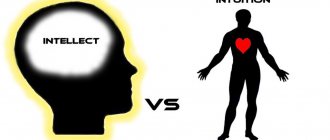Our world is full of amazing things, and it exists according to its own laws, which often defy logic and the rational mind. Operating only with precise knowledge and instructions, we can lose sight of much of what has not yet been explored and keeps a secret. And it is precisely when a person comes into contact with something that is unknown to him that his abstract thinking is activated, allowing him to reason, make some conclusions, and make guesses. This type of thinking is very important, but in order to understand why this is so and what it generally is, it is necessary to delve into its description, forms and types, examples and methods of development. This is what we will do.
The essence and benefits of abstract thinking
A person’s ability to think, in short, allows him to form a vision of the world, resolve many life situations, achieve success and generally be human. You can think precisely and generally. We operate with precise thinking when we have some knowledge and data, when we clearly understand what is happening. And generalized thinking begins to work in any opposite situation. Then we guess, assume, and draw general conclusions. To put it simply, generalized thinking is abstract thinking.
Scientifically speaking, abstract thinking is a special type of cognitive activity when a person begins to reason in general terms, moving away from specifics. Here the whole picture of something is considered, but accuracy and details are not affected. This, in turn, allows you to move away from dogmas and rules, expand your boundaries and look at the situation from different angles, and find innovative ways to solve any problem.
In most everyday situations, people start from concrete knowledge. For example, a guy sits on a bench at the entrance and cracks sunflower seeds. You might immediately think that he is a loafer and does not want to get down to business. And in this case, the basis of our reasoning is our own ideas about what is happening. However, how can this be in reality?
The guy was returning home after a hard shift at work, where he spent 24 hours patrolling the territory of a facility under construction. He has a day off and is free to do whatever he wants, including relaxing by cracking sunflower seeds on a bench. Or it could be that he had a quarrel at home, and he just quit smoking, and therefore, in order not to resume a bad habit, he bought sunflower seeds and is thinking about what happened in their company. Variants of events can be very different, and if you move away from the specifics (the guy is sitting and cracking seeds), you can abstract yourself and look at the event from different points of view and find a lot of interesting things.
Thinking abstractly, a person thinks approximately, which is very useful in everyday situations that lead him into an intellectual dead end, i.e. when he finds it difficult to find a way out or a solution, or to form an objective opinion. Abstraction allows you to find in everything that was previously invisible.
It is important to note that abstract thinking is often also called abstract-logical thinking. This clarification is typical for situations in which a person logically operates with abstractions - units of specific patterns previously isolated from the “imaginable”, “imaginary” or “abstract” qualities of any phenomenon or object. In other words, a person uses what he cannot see, hear or touch.
Abstract-logical thinking is most clearly manifested in mathematics, which explains phenomena that are absent in physical nature. For example, there is no such thing as the number “4”, and a person simply understands that four identical units are meant. The number itself was invented by people to simplify certain phenomena. As humanity developed and progressed, it became forced to apply essentially non-existent concepts.
There is another good example - human language. By themselves, there are no lexical units in nature, such as letters, words and sentences. But people created the alphabet and the phenomena arising from it to simplify the expression of their thoughts and facilitate their transmission. Thanks to this, today we can find a common language with each other, because each of us understands what a particular word means, is able to recognize letters and construct sentences. Therefore, by the way, abstract thinking and speech are closely interrelated.
We need abstract logical thinking in situations where there is some uncertainty, incomprehensibility and unknown, and, again, when an intellectual dead end arises. By thinking in abstractions and resorting to logic, we are able to find what exists in the surrounding reality and look for a definition for it.
Thus, we can highlight several useful practical capabilities that abstract (abstract-logical) thinking gives a person:
- abstraction from the framework of circumstances and separation of individual signs from an object or phenomenon;
- assessment of objects and phenomena and their comparison;
- generalization and specification of objects and phenomena;
- finding correspondences between the general and the particular;
- systematization and classification of knowledge;
- extracting what is needed and cutting off what is unnecessary for specific situations;
- analysis of what is happening;
- isolating individual components of events;
- connecting disparate information into a big picture.
Each of us already has any of these mental abilities, but they are developed and manifested to varying degrees. However, they can be successfully improved to obtain more practical benefits. Therefore, the development of abstract thinking is very important. However, we will talk about this very soon, but for now let’s understand a little more about the types of abstractions and forms of abstract thinking. But before we continue, we suggest taking an entertaining video test for abstract thinking.
Abstract-logical type of thinking
In this case, abstractions are used - these are individual units of precise patterns. They are distinguished from the abstract properties of an object, that is, those that cannot be seen with your own eyes, touched or felt.
A fairly clear example is mathematics, where scientists try to explain phenomena that do not occur in nature in material form. There is no such thing as the number 3. You and I understand that these are three absolutely identical units, and the name was developed to simplify it.
As people evolved, they began to use terms that essentially did not exist. For example, language is a set of sounds, letters and words. But you can’t touch them, and the alphabet itself was invented only so that we could formulate our own thoughts, transmit and receive information. This allowed individuals to communicate with each other.
Psychologist Daria Milai
Make an appointment
An abstract-logical thought process is necessary in the presence of some certainty or, as mentioned above, a dead end. When something that exists in reality is revealed, there is a need to give an explanation for it.
Types of abstractions
As you remember, abstract logical thinking involves manipulation of abstractions (units of specific patterns). And in order to get closer to understanding abstract thinking and its mechanism, it is necessary to talk about the types of abstractions and their purposes.
There are six types of abstractions:
- isolating abstraction – allows you to highlight the components of phenomena on which attention is focused;
- generalizing abstraction – allows you to highlight a general characteristic in a specific phenomenon, cutting off individual characteristics;
- constructivization – allows you to give clearer forms to phenomena with “blurred” boundaries;
- idealizing abstraction - allows you to replace the real properties of a phenomenon with an ideal template that eliminates shortcomings;
- abstraction of actual infinity - allows you to define infinite sets as finite;
- primitive sensory abstraction - allows you to highlight some properties of a phenomenon and ignore others.
In addition, abstractions are also divided by purpose:
- formal abstractions - necessary for considering phenomena based on external manifestations, without these phenomena not existing;
- meaningful abstractions - necessary for isolating from phenomena properties that can exist outside these phenomena - autonomously.
By operating with abstractions of all kinds (and thanks to the possibilities they provide), we can “select” from the world around us what cannot be recognized using the natural senses.
The general patterns of all phenomena are conveyed through special linguistic expressions. With them, we no longer need to identify different concepts each time, because we learn about them from the very beginning of life - from parents, educators, teachers, etc. And it is here that we need to talk about the forms of abstract thinking.
Logic is the science of conceptual thinking.
Logic, as a science of thinking, was born more than 2 thousand years ago in Ancient Greece. At the same time, the main types of logical thinking were described and the laws of logic were formulated, which remain unshakable to this day.
Two types of thinking: deduction and induction
The elementary unit of abstract-logical thinking is the concept. Several concepts combined into a coherent thought is a judgment. They are affirmative and negative. For example:
- “In autumn, the leaves fly off the trees” - affirmative.
- “There are no leaves on the trees in winter” – negative.
Judgments can also be true or false. Thus, the proposition “In winter, young leaves grow on trees” is false.
From two or more judgments one can draw a conclusion or inference, and this whole construction is called a syllogism. For example:
- 1st premise (judgment): “In autumn, leaves fall from the trees.”
- 2nd premise (judgment): “Now the leaves have begun to fly off the trees.”
- Conclusion (syllogism): “Autumn has come.”
Depending on the method on the basis of which the inference is made, there are two types of thinking: deductive and inductive.
Induction method. From several particular judgments a general conclusion is drawn. For example: “schoolboy Vasya doesn’t study in the summer,” “schoolboy Petya doesn’t study in the summer,” “schoolgirls Masha and Olya don’t study in the summer either.” Consequently, “schoolchildren do not study in the summer.” Induction is not a very reliable method, since an absolutely correct conclusion can be drawn only if all particular cases are taken into account, and this is difficult and sometimes impossible.
Method of deduction. In this case, reasoning is built on the basis of general premises and information given in the judgments. That is, the ideal option: one general judgment, one particular one, and the conclusion is also a private judgment. Example:
- “All schoolchildren have summer holidays.”
- “Vasya is a schoolboy.”
- “Vasya has a summer vacation.”
This is what the most basic conclusions in logical thinking look like. True, in order to draw the right conclusions, certain conditions or laws must be observed.
Laws of logic
There are four basic laws, and three of them were formulated by Aristotle:
- Law of identity. According to him, any thought expressed within the framework of logical reasoning must be identical to itself, that is, remain unchanged throughout the entire argument or dispute.
- Law of contradiction. If two statements (judgments) contradict each other, then one of them is necessarily false.
- Law of the excluded middle. Any statement can be either false or true, something third is impossible.
In the 17th century, the philosopher Leibniz supplemented these three with the fourth law of “sufficient reason.” Proof of the truth of any idea or judgment is possible only through the use of reliable arguments.
It is believed that it is enough to follow these laws, be able to correctly formulate judgments and draw conclusions, and you can solve any most complex problem. But it has now been proven that logical thinking is limited and often fails, especially when a serious problem arises that does not have one single correct solution. Abstract logical thinking is too straightforward and inflexible.
The limitations of logic were proven already in the era of Antiquity with the help of so-called paradoxes - logical problems that have no solution. And the simplest of them is the “liar paradox,” which refutes the inviolability of the third law of logic. In the 4th century BC. e. The ancient Greek philosopher Eubulides shocked supporters of logic with one phrase: “I am lying.” Is this a true or false proposition? It cannot be true, since the author himself claims that he is lying. But if the phrase “I am lying” is false, then the proposition becomes true. And logic cannot overcome this vicious circle.
But abstract-logical thinking, despite its limitations and inflexibility, is best manageable and itself “organizes the brain” very well, forcing us to adhere to strict rules in the thought process. In addition, the abstract form of thinking continues to be the highest form of cognitive activity. Therefore, the development of abstract thinking is important not only in childhood, but also in adults.
Forms of abstract thinking
With abstract thinking, a person operates with different knowledge and mental experiences. Over time, all this came to a certain system. Many phenomena of the world are not subject to sight, hearing or touch (and about some we can say that they do not exist at all as such). But such phenomena are part of human life, and therefore must have at least some form.
There are three main forms of abstract thinking: concept, judgment and inference. Let's talk about them briefly.
Concept
A concept is a thought that conveys a common property of various phenomena. Properties may vary, but be homogeneous and similar, which allows them to be combined into one group. Let's take a car for example. It can be an SUV, sedan or hatchback; Different cars have different shapes, colors, characteristics. But their common feature is that they all have wheels, an engine, a gearbox, etc., and that they can be driven. These characteristics (design, purpose) allow properties to be classified into one group.
And we are taught such things from the cradle. Mom talks about “cat”, and we immediately understand that this is a meowing and purring four-legged animal with a tail, etc. Cats come in different breeds and colors, but they all have common characteristics by which they belong to the general concept of “cat” or “cat”.
Judgment
A person uses judgment with the intention of confirming or disproving something. It can be simple or complex. Here is a simple thing - “the cat meows” - it can be expressed specifically and unambiguously. But the complex one - “the cat began to meow because he was hungry” - can be expressed in several declarative sentences.
Also, propositions can be true or false. True ones reflect the actual state of affairs and are based, as a rule, on the absence of an individual assessment of a person, i.e. he judges objectively. A false judgment becomes when a person expresses his interest based on personal reasons, and not on what is actually happening.
Inference
An inference is a thought formed by two or more judgments. This is a new – more complex judgment. Any inference consists of a premise, a conclusion and a conclusion. The premise is an initial judgment, the conclusion is logical thinking leading to a conclusion.
These three forms of abstract thinking form its basis. We operate all abstractions with their help. But what we have said (forms and types of abstract thinking and abstractions, their goals, etc.) may not be entirely sufficient for understanding abstract thinking and its features, since, in essence, all this is theory. Therefore, it makes sense to talk separately about specific examples.
Practice SWOT Analysis
SWOT is an assessment of the Strengths and Weaknesses, as well as the Opportunities and Threats of anything: an idea, a proposal, an object.
It’s easier to explain how this is done with an example. Let's say you're thinking about going out to fast food for dinner. Strengths: fast, cheap, tasty. Weak: harmful, high in calories. Opportunities: no need to prepare, free up time to learn programming. Threats: you can get poisoned or simply overeat, and you won’t want to do anything anymore. You can also analyze the option “write code now” or “take on another freelance job.” And make a rational choice.
Examples of abstract thinking
The clearest example of abstract thinking is the exact sciences, such as astronomy, physics and mathematics, etc. Most often it serves as their base. A person does not see numbers and formulas as such, but he can calculate, measure, count, combine objects into groups and find their quantity.
The same goes for life itself. What is life? This is when there is a body in which consciousness functions. We cannot give an exact definition of the concept of “life,” but we can say with precision when a person is alive and when he is dead.
Abstract thinking manifests itself no less clearly when we look to the future. We don't know what awaits us, but we have plans and goals, aspirations and desires. If we couldn't dream and imagine, we wouldn't be able to make plans for the future. Now we are making efforts to achieve results. Our movement through life has a direction. Abstract thinking gives us tactics and strategy that lead to the desired future. This reality does not exist yet, but we are trying to make it correspond to our ideas.
When considering examples of abstract thinking, one cannot help but recall idealization. Many idealize both the world in which they live and the people who surround them. There are, for example, men who dream of “possessing” a woman, and at the same time do not even think that one can only possess an inanimate object or a non-thinking being. There are also women who are waiting for a “prince on a white horse” and do not pay attention to what many “princes” are like in real life.
There is also an excellent example of false judgments. Let's touch on relationships again: some women believe that all men are “bad,” but this judgment is based on bitter experience - situations in which men betrayed these women. In any case, a woman identifies men as a separate class with its own specific properties, and therefore she can attribute to all of them what was manifested in one representative.
From false judgments, among other things, false conclusions often arise. For example, a house may be called “dysfunctional” because of faulty wiring, poor heating, or unfriendly neighbors. Based on his emotional discomfort that arises in the current conditions, a person makes unambiguous judgments, from which conclusions are formed that form a conclusion that distorts reality - after all, the house may well be “normal”, you just need to bring everything in it to mind.
There are many similar examples that can be given, but they will all say that abstract thinking (including the false judgments and inferences that arise from it) constitutes a colossal part of our everyday thought process. It manifests differently for everyone, and there will always be components that require development. Someone may be good at systematizing information, but find it difficult to isolate individual elements of events. Someone can perfectly find correspondences between the particular and the general, but have difficulty specifying something, etc. And in order to train your brain and improve your intellectual abilities, you need to develop abstract thinking.
Peculiarities
Abstract thinking is used by children from the first years of life. It begins to appear along with the development of articulate speech. A younger child fantasizes, thinks about unusual things, explores the world, compares his toys, using abstraction skills. They are underdeveloped, but you can still use them.
School age is combined with an increase in the importance of abstract thinking. The student will need to think outside the box when faced with solving various problems. This is especially true in mathematics, where abstraction plays a big role. Later, when the teenager is in high school, the importance of such thinking will become even greater.
Abstract thinking is also used in philosophy, writing, engineering, managerial psychology, time management and many other areas. Its good development allows you to achieve success in any field.
Signs
Thinking with abstraction has its own characteristic features. They allow us to distinguish it from other thought processes and better understand why abstraction is so useful for a person.
Signs:
- Reflection of the surrounding world without using the senses. A person does not need to use his senses or contact an object to obtain information about it. It is abstraction that allows you to use old existing knowledge to solve a particular problem.
- Generalization of phenomena. By generalizing various objects and identifying their characteristic features, a person is able to quickly access his knowledge. If he is able to identify certain patterns and similarities, then in the future it will be much easier to remember and find the necessary information in memory.
- Linguistic expression. All thoughts are easily expressed in the form of internal dialogue, which can be translated into real life. In this case, abstract concepts can be thought through in the head without the use of linguistic expression at all, and the result will be a final judgment that will be easy to express in speech.
The development of abstract thinking allows you to improve all of the characteristics listed above, which are also useful skills, without which it is difficult to achieve success.
Impact on humans
It is difficult for the average person to imagine exactly what someone with highly developed abstract thinking looks like. Such people, as a rule, always achieve their goals, they are successful and happy. At the same time, something is always happening in their heads: they reason, think about events, imagine the future figuratively, and solve difficult problems. Most often, they speak a complex language, which causes difficulties in communication. Their high efficiency allows them to occupy high positions, and their developed intelligence makes them very important for any company.
Such people may face a number of problems. They are often too selfish, which makes it difficult for them to find true friends. At the same time, people with developed abstract thinking cannot show enough physical activity and are passive in practical work. Sometimes they are careless in appearance, which alienates others.
Most often, men in technical professions have developed abstract thinking.
Why develop abstract thinking?
Let's start small: abstract thinking, constantly present in our lives, begins to form from an early age. Remember how, as children, you fantasized and made up all sorts of fables. This is how your abstract thinking developed, with the help of which you abstracted from something concrete and began to perform all sorts of manipulations with its properties.
During your school years, this skill helped you master mathematics and other sciences. Then, at an institute or university, you solved many abstract problems with its help. And finally, already in the professional sphere, abstract thinking allows you to operate with huge amounts of data, many tasks and their properties, divide them into groups according to different parameters, solve problems and even find a relationship between what you do and the meaning of your life.
Time management, engineering, philosophy, psychology, and writing are just a few areas where abstract thinking is involved. In addition to this, solely with its help, you can dream about the future and make plans, think about God and love, use your sense of humor and joke, and create something new. It’s simply impossible to list everything, and is there any point in that?!
Abstract-logical thinking makes a person a rational being and helps to see what is “not there,” create space in chaos and understand the phenomena of the surrounding world. The importance of these abilities cannot be overestimated, and even they are quite enough to understand why you need to develop abstract thinking - in order to achieve better results in everything, increase your level of intelligence, achieve success and conquer new heights. But the most surprising thing is that completely simple methods are suitable for this.
Why is it necessary to develop these skills?
This type begins to develop in a child from an early age. Every child loved to fantasize and daydream as a child, imagining things that are unlikely to happen. This is the very thinking when we abstracted from reality.
Ask a question
At school, this skill contributed to the study of exact fields of science (the same geometry). At university, the ability was also useful in solving numerous abstract problems. And finally, at work we distribute responsibilities, group them according to specific characteristics, cope with difficulties and often even find some connection between them. We do the same thing when we think about the meaning of our own lives.
There are quite a few areas where this property plays a major role. This is a philosophical teaching, and writing, and psychology. Another advantage is that we can dream, plan for the future, talk about religion or joke. And this list can be continued endlessly.
Such reflections allow us to remain developed and intelligent. We see what formally does not exist, and we know how to study the phenomena of reality. Therefore, the importance of this improvement cannot be overestimated - this is how we increase intelligence, achieve success both at work and in personal life, and use simple methods for this.
Development of abstract thinking
In this block we want to briefly talk about how to develop abstract thinking in children and adults. Considering that the methods of its development in these cases will differ, we will talk about them separately.
Development of abstract thinking in children
Despite the fact that abstract thinking develops automatically in a child, parents can create special conditions to improve this process. It is recommended to start classes from the first years of life, when the child's brain is formed and growing. The main task is to help the child move from operations with specific objects to working with abstract concepts, as well as broaden his horizons as much as possible.
Here are some suitable exercises for this:
- Take a landscape sheet and spill a little gouache or ink on it to make a blot. Together with your child, you need to make some kind of drawing from this blot, for example, a cheerful face or a funny little man.
- Come up with unusual titles and names together with your child. You can pick up an image on the Internet and come up with at least three interesting names for it. Unusual names can be made for animals and even people.
- Put on small theater productions with your child. Create costumes and other props from scrap materials. Abstract thinking in children is excellently developed by shadow theater games.
Along with these exercises, solve puzzles, rebuses, riddles and anagrams with your child. Play logic games and chess, collect puzzles and make associations. Initially, the baby may have difficulty completing tasks, but very soon his abstract thinking will develop very quickly, much faster than that of an adult.
Development of abstract thinking in adults
Developing abstract logical thinking in an adult is a little more difficult than in a child. The fact is that the thinking of an adult has already been formed and has become less flexible. New knowledge is more difficult to perceive and assimilate. But this is not a hindrance if you perform special exercises to develop creativity and the ability to think in abstract categories:
- Close your eyes and imagine as vividly as possible everyone you interacted with during the day. Do this in every detail: remember clothes, timbre and volume of voice, gestures, facial expressions. At the same time, remember your feelings in the process of communicating with people.
- Close your eyes and begin to imagine different emotions: joy, horror, fear, tenderness, anxiety, distrust, etc. Create in your mind an image of an emotion without a specific object.
- Close your eyes and imagine an image of an idea, concept or term that interests you. Try to track the associations, sensations and symbols that arise. Such abstract phenomena as infinity, energy, freedom, space, religiosity, etc. are great for performing the exercise.
In addition to the proposed exercises, the same puzzles, rebuses, logic problems, Sudoku are suitable; practice drawing and invent non-existent words and expressions. Also try reading books in an unusual way - backwards, upside down, diagonally, etc.
Also pay attention to books on abstract thinking. Among the most popular are “Abstract Thinking” by Kirill Berendeev, “Intelligence Training” by Andrei Rodionov, “Develop Your Intelligence” by Philip Carter, “Teach Yourself to Think” by Edward de Bono, “Brain Rules” by John Medina and other works.
Learn to think abstractly. If we had not been able to do this, it is unlikely that the first airplane or car would have appeared, and there would not have been many discoveries and stunning technical progress. All this comes from the human ability to imagine, fantasize, and go beyond the boundaries of what is reasonable and familiar. Knowing how to think in abstractions, each of us easily rebuilds and adapts to circumstances, finds ways out of situations and solves problems, creates and creates, thinks, reasons, analyzes and predicts.
However, we think that it will be useful for you to also get acquainted with a professional point of view on abstract thinking. In the video posted below, Professor of the Higher School of Economics, Doctor of Physical and Mathematical Sciences, teacher and consultant on strategic management and corporate governance Gennady Nikolaevich Konstantinov talks about its importance. We wish you pleasant viewing and, of course, successful development of thinking in any direction that is important to you!
We also recommend reading:
- Storytelling
- Intelligence and its development: several recommendations
- Development of thinking: ways to train the brain
- How and why to develop thinking
- Combinatorial thinking
- Thinking: what it is and how it happens
- Language and thinking
- Exercises for the brain. Part two
- Types of thinking
- How does thinking work?
- Scientific thinking: meaning, features and methods
Key words:1Cognitive science
Exercises for children
It is easiest to develop in childhood. At this time, the brain is open to external influences and can undergo any changes. Exercises for children differ from those offered to adults, but are no less effective.
Best exercises:
- Reverse reading of inscriptions. Parents should invite their child to play a game in which they read the signs they see in reverse order. It will be very difficult to do this with all the advertising posters. Therefore, additional conditions should be negotiated (for example, read only red signs).
- Drawing unusual animals. The child must draw an animal consisting of parts of other animals. When the drawing is ready, you need to come up with an unusual name for the new species.
- Shadow play. With the help of his hands, on which the light from a lamp falls in the dark, the child must create unusual shadows depicting certain things. You can even invite him to act out his favorite fairy tale using shadows.
- Mental arithmetic. The child will be required to calculate simple examples using special abacus called an abacus. Such training will also develop perseverance and general intelligence.
- Puzzles. You need to choose puzzles, rebuses, anagrams, etc. games, taking into account the baby's preferences. His task will be to solve all the problems provided. At an older age, you can add crosswords to them.
- Studying clouds. The child should look at the clouds together with his parents and name what exactly he sees. The ability to visually evaluate each cloud for its similarity to different objects or animals increases the chances of successful development.
- Construction. Parents need to give their baby a task, which involves building certain objects from toy blocks. This will help develop imaginative thinking and creativity.
- Associations. The baby needs to come up with associations for everything he sees or feels. You can also ask him to imagine animals by hearing the sounds they make.
- Classification. The child needs to sort all available things or toys according to certain criteria. For example, by shape, weight or purpose. Parents should monitor the process and give hints if necessary.
- Questions. Parents should ask their child “why?” and “what if?” questions. etc. to make him think and analyze the situation. You can ask at any time.
Such simple exercises will allow you to achieve good results in a few weeks of training. It is recommended to combine them with other activities that will be aimed at developing general intelligence.
Using special tests, you can accurately determine the level of abstract thinking in a person of any age.
How to learn to abstract yourself
Anyone can abstract, often this happens unconsciously, as a defensive reaction from the surrounding reality. Learning to do this is useful to maintain composure, control thoughts and isolate yourself from the negativity of social life. Abstraction will help you ignore negative manifestations; an example of this is the memory of a pleasant evening or childhood years.
From society
To abstract yourself from society, you need to concentrate on positive moments, learn to rest, and relax. It is important to clearly formulate thoughts and goals; this will help you understand your role in society and concentrate at the right time. This is facilitated by planning the day, drawing up plans, and the ability to prioritize goals. If, for example, noise interferes with concentration, you need to imagine it as a background that will not stop without concentrating on it. Then the brain will stop paying attention to the noise. Slow breathing on a count will help you to disengage. You need to relax and count to ten.
It will never be possible to isolate yourself from society and crowds; it is impossible to avoid crowded places. A negative reaction will be reduced by a proper daily routine and good nutrition. Imagination will help you transport yourself to a pleasant place.
Note! Thought processes suppress negative emotions. Stress and lack of sleep contribute to impaired abstract thinking.
Abstraction
From a person
To abstract yourself from a person, you need to not concentrate on the negative. If emotions take over, take a break. For example, stop communicating for a while. Distraction will help you switch to something positive.
You need to concentrate on the positive qualities of a person, paying a lot of attention to them. Remember what happened more in life related to him: good or bad. Focusing solely on the negative only hurts the relationship. Abstraction is the ability to sweep away the unnecessary.
From unpleasant people
When communicating with people does not bring pleasure, but you cannot stop it, you need to learn to abstract yourself. To do this, it is important to understand what exactly leads to negative emotions, identify the problem and begin to fight it. Communication and conversation with unpleasant people can help correct the situation. A calm dialogue in which the problem is voiced will get rid of the irritating factor.
From the situation
Looking at it from the outside will help you abstract yourself from the situation, as if it were happening to another person. Emotions become dull, the mind becomes clear, and solving the problem becomes much easier. You can imagine that this is a film and you need to figure out what the main characters should do to get rid of the negativity.
In any situation, you need to notice only what is important, filtering out unnecessary details. Perhaps they are what lead to irritation. Understanding that this is not worth attention will help you calm down and cope with negativity.
Abstract thinking helps you survive and become happy in the modern world. After all, there is not always an exact plan, and it is impossible to have all the knowledge. An abstract person is able to come to conclusions by analyzing available facts. The main thing is to be able to build logical chains and use your imagination. It is abstraction that helps a person draw conclusions and make decisions.











